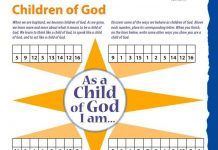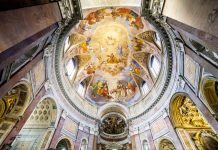
by Lou Ella Hickman, IWBS
See the end of this article to
learn about the history of the Catholic Church in the United States.
The start
of a new year is often compared to the beginning of a journey—usually emotional
or spiritual. This new year is special, as it includes the Church’s celebration
of the Year of Faith.
As I write
this, my own diocese is celebrating 100 years of its own journey of faith.
Stories of the pioneers whose faith and courage helped create and shape the
Church in this part of Texas are taking center stage. How blessed we are to
have our diocesan celebration intertwined with this year that celebrates the
faith story of the universal Church.
Plan now
for ways to observe the Year of Faith through the months ahead. Here are some
ideas.
Scripture:
Our
faith story begins with the journey of Abraham (see Catechism of the Catholic Church, n. 146). Part of that journey was
his test of faith when God asked him to sacrifice his son, Isaac. Read this
story to your students (Genesis 22:1-19) and talk about the test of faith that
God gave Abraham. Perhaps the story is more about what Abraham learned about
God and himself.
The New
Testament recounts St. Paul’s journeys to spread the Good News. His journeys
are mapped in the back of most editions of the Bible. Have students calculate
the number of miles Paul traveled on his journeys.
The
catechists in your parish may want to start a Bible study group. Read and
discuss the various stories in the Gospel of John, the Gospel whose theme is
faith.
Feasts: In preparation for the
Solemnity of the Annunciation (celebrated April 8 this year), show the first 15
minutes of the movie The Nativity Story (New
Line Cinema). How does the movie put
“a face” on Mary and Joseph?
A feast to
consider studying at the end of the school year is Our Lady of the Blessed
Sacrament. The feast day is May 13.
Local
history:Research
the history of your parish and/or diocese. Have students make a booklet titled Stories of Faith, about the men and
women who were the pioneers of your parish and/or diocese. If your parish is
new, invite the first members to share their stories of faith.
If
possible, have your pastor tell his story of being called to the vocation of
the priesthood. If there are religious orders in your city, invite a member to
share his or her vocation story.
Personal
stories:The
RCIA members have been together for some months now. Ask the director of the
RCIA to suggest names of people you might invite to share their journeys of
faith. Also invite those who came into the Church last year to share faith
stories from this past year.
If you
have not shared your own story of faith with your students, this would be a
good time to do so. Include in your sharing how the Sacraments sustain your
faith.
Suggest to
the DRE that he or she schedule a time for all catechists to gather for a time
to share their stories of faith with one another.
Prayer: As a class, create a
prayer of petitions titled “Our Litany of Faith.” Pray it together to open or
close class sessions during the Year of Faith. Examples of petitions are “That
we may come to know Jesus better” and “That we may take time to pray.” An
example of a response is “Lord, increase our faith.” Create as many petitions
about faith as you and your students would like.
Sister Lou Ella is a spiritual director. She has
a master’s degree in theology from St. Mary’s University in San Antonio, TX.
For over 17 years, she taught at all levels and has served as a part-time
librarian.
The History of the Catholic Church
in the United States
The United
States is a nation of immigrants. Yet, how many of us understand what that
means in terms of the actual number of Catholic immigrants who came to this
country during the nineteenth century and early twentieth century?
In 1820,
there were 195,000 Catholics in America. By 1920 there were 18 million (see American & Catholic: A Popular History of Catholicism in the United
States by Clyde F. Crews; St. Anthony Messenger Press © 2004, p.73 and
p.104). In fact, the number of all immigrants was so large by the early
twentieth century that Congress passed a series of laws (the final one in 1924)
limiting the number of those who could enter our country.
As a
result of this large influx of immigrants, the bishops of the United States
were hard pressed to minister to the ever-increasing number of Catholics who
came to America from various countries. Most Catholic immigrants spoke and read
little if any English. They needed a simple and to-the-point tool to help them
practice their faith.
As a
result of this need, the Third Plenary Baltimore Council of 1884 created a document that would become the bedrock of
Catholicism in the United States for almost 100 years: the Baltimore Catechism.
Here are
some activities to help your learners explore the history of the Catholic
Church in the United States in the nineteenth century and early twentieth
century.
The Third
Plenary Baltimore Council was convened only 20 years after the Civil War. The
catechism was only one of the results of the council. Other results included:
* the
intention to establish a Catholic school in every parish (ACTIVITY: If there is a school attached to your parish, invite the
principal to speak to your class about the ministry, vision, and practical
responsibilities of his/her job.)
* the establishment
of the six holy days of obligation (ACTIVITY:
Have students discuss the various reasons for the bishops’ choice of these six
feasts as holy days of obligation: the Immaculate Conception, December 8; the
Nativity, December 25; Mary, Mother of God, January 1; the Ascension, 40 days
after Easter, often celebrated on the Seventh Sunday of Easter; the Assumption
of Mary, August 15; All Saints, November 1.)
* the
mandate of specific priestly attire (ACTIVITY:
Invite your pastor to show students how he puts on his Roman collar and to
explain the vestments he wears at Mass. Students could write vocation thank-you
notes to your parish pastor/seminarians.)
A parish
priest has been using the Baltimore
Catechism for five years. He reports to his bishop the results of using the
catechism in his parish during that time. (ACTIVITY:
Suggest ways the Baltimore Catechism might
be helpful to you in understanding the teachings of the Catholic Church.)
Many of the
Irish who came to the United States did so to escape the Great Famine in
Ireland, 1845-1851. (ACTIVITY: Act
out a scene of a family in Ireland who is trying to decide about going to America.
Be sure to include various aspects of the Catholic faith in the role-playing.)
Many
Germans came to America as political refugees after several failed revolutions
in 1848. (ACTIVITY: Act out a
discussion of several families deciding to come to America. Be sure to include
various aspects of the Catholic faith in the role-playing.)
Many Italians
left Italy due to the country’s great poverty. (ACTIVITY: Have students act out a family saying goodbye to friends
and relatives before they leave for America. Include some of the advice this
family will receive about practicing their Catholic faith and how their faith
will be their strength after they arrive.)
The
American Catholic Historical Society was founded in 1884. (ACTIVITY: Go to the society’s website—amchs.org—and click on ABOUT in the menu bar at the top. Then click
on HISTORY for a brief history of the society. The second paragraph of the
history tells about a group of Philadelphia citizens who gathered to form this
society. Act out a scene that might have taken place at that first gathering.
Be sure to incorporate into your role-playing a discussion about what is unique
to Catholicism, such as the Seven Sacraments, devotion to Mary, and the teaching
authority of the pope. You might also want to incorporate topics from your students’
textbook.)
Bishop
John England came to America in 1820. (ACTIVITY:
Do research to find out who Bishop John England was. What were his
contributions to the American Church in the 1800s?)
Many
committed Catholics influenced the Church in the United States during the
nineteenth century and early twentieth century. (ACTIVITY: Have students research some of these people, such as John
Neumann, Francis Xavier Cabrini, Mother Margaret Healy Murphy, Marianne Cope,
James Gibbons, Pierre Toussaint.)
There were many religious orders of men and
women who ministered to immigrants in the United States during the nineteenth
century and early twentieth century. (ACTIVITY:
Research the history of religious orders of men and women with which you
are familiar to see what contributions these orders made to the Church in the
United States during the eighteenth and early twentieth centuries. Have
students select a man or a woman from one of these religious orders and then
write letters to young people today from that person’s point of view.)
The Catechism
of the Catholic Churchis available on line at old.usccb.org/catechism/text. (ACTIVITY:
Review the Index, select topics of interest, and carefully read those
selections on a regular basis.)
The Baltimore
Catechismis available online at pcpbooks.net/docs/baltimore_catechism.pdf
and catholicity.com/Baltimore-catechism. (ACTIVITY:
Spend time studying the Baltimore
Catechismand see how it is similar to and different from the Catechism of the Catholic Church.)
The United
States Catholic Catechism for Adultsis an adaptation of the Catechism of the Catholic Church. It is
available from USCCB Publishing, usccb.publishing.org. (ACTIVITY:
Commit to reading one chapter a
day.)
Copyright 2013, Bayard, Inc. All rights reserved. This article is protected by United States copyright and other intellectual property laws and may not be reproduced, rewritten, distributed, redisseminated, transmitted, displayed, published or broadcast, directly or indirectly, in any medium without the prior written permission of Bayard, Inc.
This article was written by the Catechist Staff and appeared in Catechist magazine, December 2012.
Image Credit: MIA Studio/Shutter Stock 557176453




